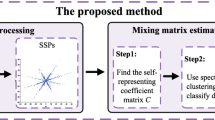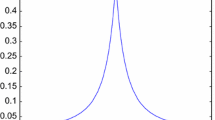Abstract
In this paper the K-hyperplanes clustering problem is discussed and we present a K-hyperplanes clustering algorithm, which can be applied to sparse component analysis (SCA) for linear model X=AS+V, where X is a m by T matrix of observation, A is an unknown m by n basis matrix and S is an unknown n by T matrix of sparse sources. The proposed algorithm is suitable for a relaxed case when more than one source signal achieves significant value at any time instant. More precisely, in this paper we propose a new algorithm which is suitable for the case when the (m-1) source signals are simultaneously nonzero for sufficient number of samples, where m is the number of observation. In contrast to the conventional SCA algorithm which is based on the assumption that for each time, there is only one dominant component and others components are not significant. We assume that the sources can be only moderately sparse. However, the complexity of the algorithm is higher than that of the conventional SCA algorithms. We confirmed the validity and good performance of the proposed algorithm by computer simulation.
Preview
Unable to display preview. Download preview PDF.
Similar content being viewed by others
References
Georgiev, P.G., Theis, F., Cichocki, A.: Sparse component analysis and blind source separation of underdetermined mixtures. IEEE Trans. on Neural Networks 16(4), 992–996 (2005)
Parra, L., Spence, C.: Convolutive blind separation of non-stationary sources. IEEE Trans. Speech and audio processing 8(3), 320–327 (2000)
Aharon, M., Elad, M., Bruckstein, A.M.: K-SVD and its non-negative variant for dictionary design. In: Proceedings of the SPIE conference wavelets, July 2005, vol. 5914 (2005)
Li, Y.Q., Amari, S., Cichocki, A., Ho, D.W.C.: Underdetermined Blind Source Separation Based on Sparse Representation. IEEE Trans. on Signal Processing 54(2), 423–437 (2006)
Li, Y.Q., Cichocki, A., Amari, S.: Blind estimation of channel parameters and source components for EEG signals: A sparse factorization approach. IEEE Transactions on Neural Networks (2006) (accepted for publication)
Brandwood, D.: A complex gradient operator and its application in adaptive array theory. Proc. Inst. Elect. Eng. 130, 11–16 (1983)
Janich, K.: Einfuhrung in Die Funktionentheorie, ch. 2. Springer, Berlin (1997)
Bofill, P., Zibulevsky, M.: Undetermined blind source separation using sparse representations. Signal processing 81, 2353–2362 (2001)
Li, Y.Q., Cichocki, A., Amari, S.: Analysis of sparse representation and blind source separation. Neural computation 16, 1193–1234 (2004)
Takigawa, I., Kudo, M., Toyama, J.: Performance analysis of Minimum l1-norm solutions for underdetermined source separation. IEEE Trans. Signal processing 52(3), 582–591 (2004)
Yilmaz, O., Rickard, S.: Blind separation of speech mixtures via time-frequency masking. IEEE Trans. Signal Processing 52(7), 1830–1847 (2004)
Babaie-Zadeh, M., Mansour, A., Jutten, C., Marvasti, F.: A geometric approach for separating several speech signals. In: Puntonet, C.G., Prieto, A.G. (eds.) ICA 2004. LNCS, vol. 3195, pp. 798–806. Springer, Heidelberg (2004)
He, Z., Cichocki, A.: K-EVD Clustering and its Applications to Sparse Component Analysis. In: Rosca, J.P., Erdogmus, D., Príncipe, J.C., Haykin, S. (eds.) ICA 2006. LNCS, vol. 3889, pp. 90–97. Springer, Heidelberg (2006)
Author information
Authors and Affiliations
Editor information
Editors and Affiliations
Rights and permissions
Copyright information
© 2006 Springer-Verlag Berlin Heidelberg
About this paper
Cite this paper
He, Z., Cichocki, A., Xie, S. (2006). K-Hyperplanes Clustering and Its Application to Sparse Component Analysis. In: King, I., Wang, J., Chan, LW., Wang, D. (eds) Neural Information Processing. ICONIP 2006. Lecture Notes in Computer Science, vol 4232. Springer, Berlin, Heidelberg. https://doi.org/10.1007/11893028_116
Download citation
DOI: https://doi.org/10.1007/11893028_116
Publisher Name: Springer, Berlin, Heidelberg
Print ISBN: 978-3-540-46479-2
Online ISBN: 978-3-540-46480-8
eBook Packages: Computer ScienceComputer Science (R0)




